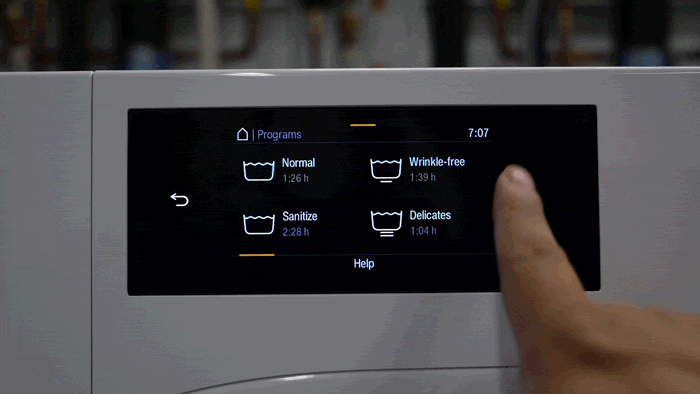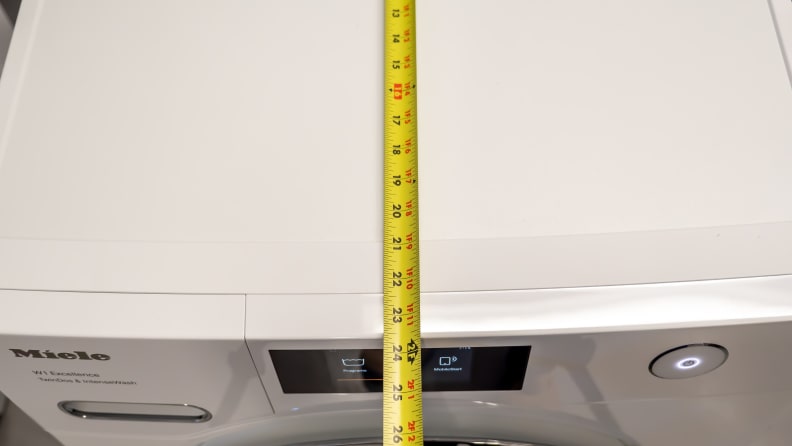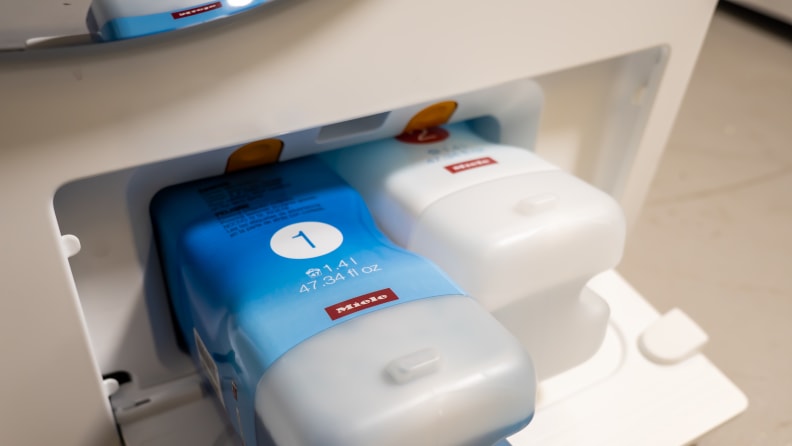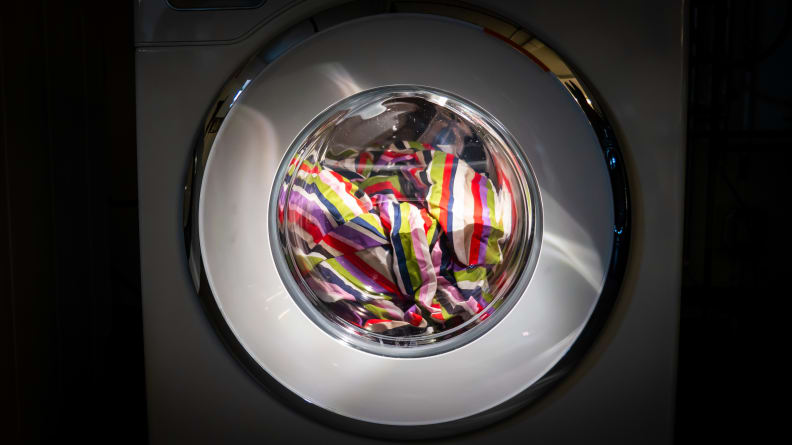Pros
-
Powerful cleaning
-
Effective spin cycle
-
Smart features
Cons
-
Expensive
The Miele W1 WXR860WCS has a fairly standard layout for a compact washer. The top left corner is where you’ll find your detergent dispenser, with touch controls towards the middle and a large power button off to the right. Opening up its door reveals a standard, 2.26-cubic-foot drum.
About the Miele W1 WXR860WCS

We liked the Miele W1's touch controls, which were responsive and intuitive.
Dimensions: 33.5 inches x 23.5 inches x 25.38 inches (H x W x D) Capacity: 2.26 cu. ft. Finishes: White Cycles: Delicates, Express, Dark Garments, Denim, Outdoor, Proofing, Trainers, Clean Machine, Starch, Normal, Wrinkle-free, Sanitize, Dress Shirts, Extra White, Quick30, Intense, Table Linens/Drapes, Sportswear, Woollens, Silks, Drain/Spin, QuickRinse, Baby Clothes, Towels, Downs, Pillows Cycle options: SingleWash, Soak, Pre-rinse, Pre-ironing, AllergoWash, and Degree of Soiling Matching dryer: Miele T1 TXR860WP User manual: Miele W1 WXR860WCS manual
What we like about the Miele W1 WXR860WCS
It offers decent cleaning—especially for a compact washer

You can use whatever detergent you prefer in the top-left dispenser.
Compact washers, due to their smaller size, often have difficulty keeping up with other washers that leverage larger loads of laundry to scrub out stubborn stains. While this is still somewhat the case for the Miele W1 WXR860WCS, it does a pretty good job keeping up with full-size units.
Depending on the cycle, an average full-size unit can scour off anywhere between 67% and 77% of our test strips’ stains. This is exactly where the W1 falls. Its Normal cycle and Sanitize cycles lagged behind the average washer’s normal and heavy cycles by 3% and 4% respectively, but its Delicates and Quick30 cycles were able to clean away 4% and 7% more stains than average.
We would’ve expected all of the cleaning scores to be solidly below average compared to a full-size unit, but the W1 exceeded our expectations, making it notable amongst compact washers. If you don’t have a lot of space, but also don’t want to compromise on clean laundry, the W1 is a great pick.
The spin cycle gets rid of a lot of water

The W1 is less than 24 inches from front to back; standard washers average around 33 inches.
One of the other typical issues you’ll find in a compact washer is that it lacks the power necessary to spin out excess water. While not a dealbreaker, it’s significantly more energy efficient to spin out water than evaporate it in the dryer.
Regardless of the cycle or test load we used, the W1 was excellent at spinning out excess water. The Normal and Sanitize cycles ended with about 10% less water than the average washer, while the Quick30 and Delicates cycle got rid of 3% and 5% of the water respectively.
To put these numbers in context, the W1 isn’t necessarily leaps ahead of average, but again, we’re comparing it to a field of full-size units here, making its performance all the more impressive: You won’t be losing much power with the W1’s smaller size.
It comes with some nice extra features

The TwinDos system accepts proprietary pods and will automatically and precisely dole out doses of detergent.
The W1 comes equipped with Miele’s smart platform, Miele@home, allowing you to control the device via an app or voice commands in your existing smart home setup. This means you’ll have access to the usual suite of smart features you’d expect on a washer, such as remote control and notifications.
The W1 also features an automatic detergent dispenser in a drawer in its lower right corner. This dispenser works with proprietary pods of detergent and “detergent enhancer” (aka a bleaching agent), which Miele claims can reduce waste over manual dispensing by up to 30%. Of course, those who don’t want to buy in to Miele’s system can still use whatever detergent their hearts desire in the top-left detergent dispenser.
What we don’t like about the Miele W1 WXR860WCS
The Delicates cycle isn’t delicate

The W1 has an interior LED, to help loading in dimly-lit laundry rooms.
To measure how rough a wash cycle is on clothes, we use a mechanical action strip: a swatch of fabric with a hole punched out in the center. After a wash, we count how many threads were pulled free from the fabric.
On average, we expect to see about 51 threads pulled free during a normal cycle and 30 during a delicate cycle. The Miele W1 WXR860WCS’s Normal cycle had 55 threads pulled—more or less average—and the Delicates cycle resulted in 50 threads pulled—technically more delicate, but only slightly so.
If you have a lot of delicate garments to clean, there are better options for you than the Miele W1 WXR860WCS, such as the GE GFW148SSMWW.
What owners are saying
As a newer, higher-end, compact washer, the Miele W1 WXR860WCS is a bit of a niche appliance: There aren’t many user reviews currently available online.
Warranty
Miele offers a standard 1-year warranty that covers parts and labor, or, if your W1 WXR860WCS was installed by a Miele-authorized technician, 2 years.
While we do appreciate the extended warranty under certain conditions, other manufacturers often go further: LG, Samsung, and Speed Queen, for example, will guarantee certain parts for up to 10 years. Given the investment you’re making in the W1, we would’ve liked to see a slightly more robust program.
Should you buy the Miele W1 WXR860WCS?
Yes—If you need a compact washer
Overall, we are impressed with the Miele W1 WXR860WCS. It put up pretty good numbers on a lot of our tests, showing it can compete with full-size units despite its compact size.
We also like its extra features—a rarity on compact models—which grant users access to smart features and the option to buy into Miele’s proprietary detergent dispenser system, which can be a convenience.
The one downside is its price. The Miele W1 is very expensive, even compared to other compact washers. Still, its test results make a good case for its price being a bit higher. If you’re looking for a high-end, compact washer, the field is pretty small: The W1’s relatively high performance certainly stands out.
If you’re in the market for a great compact washer, we also recommend checking out the LG WM1388HW, especially for newer families who need a supplemental washer to handle all their baby’s laundry.
Meet the testers
Mark Brezinski works on the Home Team, reviewing refrigerators, minifridges, dishwashers, washing machines, dryers, air conditioners, air purifiers, and fans.
Jonathan Chan currently serves as the Lab Manager at Reviewed. If you clean with it, it's likely that Jon oversees its testing. Since joining the Reviewed in 2012, Jon has helped launch the company's efforts in reviewing laptops, vacuums, and outdoor gear. He thinks he's a pretty big deal. In the pursuit of data, he's plunged his hands into freezing cold water, consented to be literally dragged through the mud, and watched paint dry. Jon demands you have a nice day.
Checking our work.
Our team is here for one purpose: to help you buy the best stuff and love what you own. Our writers, editors, and lab technicians obsess over the products we cover to make sure you're confident and satisfied. Have a different opinion about something we recommend? Email us and we'll compare notes.
Shoot us an email








